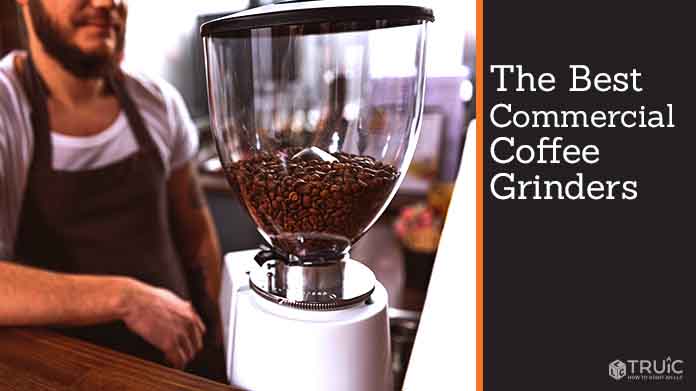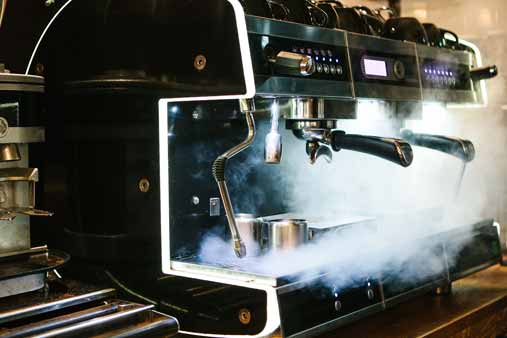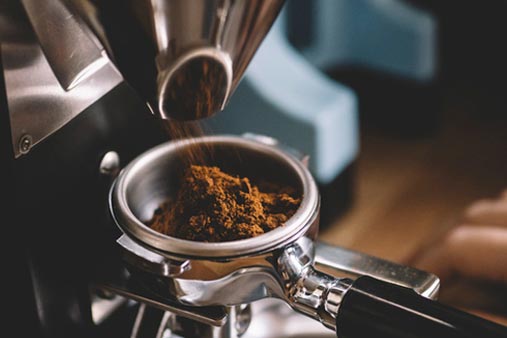The Best Commercial Coffee Grinders
Specialty coffee aficionados understand the necessity of finding the right equipment for thier cafe. Preparing high-quality espresso or drip coffee while keeping up with the fast-paced environment of a successful coffee shop requires a consistent and easily adjustable grinder. A commercial coffee grinder is an indispensable piece of equipment and finding the right one can be difficult. That's why we created this guide to help you evaluate commerical coffee and espresso grinders for your cafe. Trust us: once you upgrade, your customers and your baristas will thank you for it.
In this guide we provide an overview of different types of commercial coffee grinders as well as pricing and overall ratings for some of the best options for both espresso and drip coffee.
Recommended: Read our full, in-depth How to Start a Coffee Shop Business guides, inspired by coffee professionals, they will help make your coffee dreams real, from sourcing beans to hiring baristas, choosing a POS system, forming an actual company, and everything in between.

Burr vs. Blade Grinders
If you look into a typical home coffee grinder, you’ll likely see the two blades used to grind whole beans. While blade grinders provide a good option for home brew methods, the speciality coffee world prefers burr grinders.
Why?
The main difference between these types of grinder is the method in which they grind the coffee. Blade grinders operate like a blender, slicing the beans up quickly with two or three blades. Burr grinders, on the other hand, have two pieces — either conical or flat — that slowly grind the beans into even, uniform pieces.
While both types of grinder can produce a consistent grind, a burr grinder’s slow, even grind gives baristas greater control.
Conical vs. Flat Burr Grinders
Both conical and flat burrs grind coffee the same way. That makes other factors, such as price and adjustability, more important when purchasing a coffee grinder than the differences between these two types of burr grinder. Nevertheless, understanding the two options can help you better assess the machine you plan to buy.
Burrs grind coffee using two ring-shaped plates — one serrated and the other jagged. The coffee beans move between the rings to produce a uniform grind. In a flat burr grinder, coffee beans drop between two horizontal rings and then ground coffee drops down again for dispensing. Conical burrs have a cone shape, making the entire grinding process vertical from the hopper to the spout.
Recommended Commercial Espresso Grinders
Made specifically for espresso, these grinders differ from general coffee grinders in several key ways. They not only feature a hopper to hold beans and spout tubes to easily dispense coffee grounds into a portafilter, but they also enable baristas to easily adjust the coarseness of the grind. Here are two recommended options:
Mahlkonig PEAK Espresso Grinder
One of the newest additions to Mahlkonig’s espresso grinder lineup, the Mahlkonig PEAK Espresso grinder pairs the quality of Mahlkonig’s classic grinders with the latest features to create perfect espresso. Some of this grinder’s innovative features include an adjustable spout tube, double ventilation for cool grinding, and the ability to make an accurate dose adjustment in 0.01 seconds. Each feature gives baristas complete control of the grind while maintaining a high degree of usability.
Price: $2,800
Included Features – 4.5/5
This grinder includes cutting-edge features built to enhance a barista’s experience and performance. Each automated feature allows for fast adjustments.
Ease of Use – 5/5
This grinder’s automation enhances usability, empowering baristas to deliver a reliable grind every time with fewer adjustments.
Value – 4/5
While its features make it well worth the money, this model remains one of the more expensive espresso grinder options.
Mazzer® Kony Electronic Conical Burr Grinder
A classic choice, the Mazzer Kony Electronic grinder is a dependable and widely appreciated grinder for specialty coffee preparation. Known for its ability to produce a consistent and easily adjustable grind, this machine also maintains a barista’s ability to control the steps of the process by simplifying manual dosage. Key features include a pronged portafilter holder, ventilation for reduced heat exposure, and the ability to make adjustments in less than 0.05 seconds.
Price: $2,150
Included Features – 3.5/5
While manufactured for quality and ease of use, this grinder offers fewer additional features than some of its competitors.
Ease of Use – 4.5/5
Easy adjustments are the focus of this grinder. Its automated aspects make changing grinds both simple and fast.
Value – 4.5/5
While more expensive than some of its competitors, this long-lasting, solid grinder is well worth the investment.
Recommended Commercial Grinders for Drip Coffee
Grinders designed for drip coffee and any other non-espresso coffees typically include a larger spout as well as 15 to 20 settings based on desired grind coarseness. Here are two recommended options:
Mahlkonig EK43
When Mahlkonig introduced the EK43 grinder in 2013, it put all commercial coffee grinders to shame. With unparalleled precision and a uniform grind made possible by a 98-millimeter burr and a powerful motor, this grinder produces consistently ground coffee at high speed. Its smaller cousin — the EK43 S — works well for smaller coffee shops.
Price: $2,700
Included Features – 5/5
The most innovative coffee grinder available, the EK43 features elevated power and burrs as well as a large hopper to enhance the grinding experience.
Ease of Use – 4/5
With its large hopper and user-friendly dial for adjusting the grind, the EK43 makes producing a perfect grind fast and easy.
Value – 3.5/5
This grinder has a pretty steep price given its innovative and exceptional build. However, the high cost may not suit all business owners.
Mahlkonig Gautemala 710
A favorite in the coffee world, this grinder boasts a 71-millimeter steel burr that produces a uniform grind with settings for everything from espresso to French press coffee. Other key features include a sleek matte finish, a bag clamp, and a tray to catch loose grounds for a simpler cleanup. This grinder is perfect for business owners seeking a less-expensive, tried-and-true favorite.
Price: $1,680
Included Features – 3/5
The Guatemala 710 is a fairly straightforward grinder with few innovative, additional features. It works best for coffee shops that want a simple, long-time favorite vs. the latest features.
Ease of Use – 4/5
With a bag clamp, a loose grounds tray, and a list of grinds perfect for various brew methods, this grinder makes coffee preparation and cleanup easy.
Value – 4.5/5
While it’s a bit more expensive than other machines, the Guatemala 710 is more affordable than some of the newer models while maintaining the necessary elements to produce a uniform grind.
How to Make the Most of Your Grinders
Whichever grinders you choose for your cafe, these four tips can help you extend the life of these hard-working machines:
Replace the burrs
This will depend on how many pounds of coffee your cafe grinds a day and each model is different. For example: The Mazzer Kony recommends burr replacement at 1,640 lbs of coffee ground throughout. To determine how frequently you should replace your burrs, look up your manufacturer's recommendation.
Wipe out hopper and burrs
This should be done daily and whenever you switch either coffees or date of roast if you are using the grinder for the same coffee every time.
Completely clear coffee from the grinder
Every evening as well as when you switch coffees or roast dates, clearing any grounds from the burrs and throat of your grinder with a vacuum hose or rag. We recommend a Shotvac or similar to make this process easy for your employees during closing time.
Conclusion
The first adjustments you make to the coffee you serve start with your grinders. Whether you choose a conical or flat burr, selecting the right grinders for your shop is an important step in the process of preparing specialty coffee. For more information about key equipment for your cafe, check out The Top 5 Commercial Espresso Machines and how to find the right equipment for your cafe.


